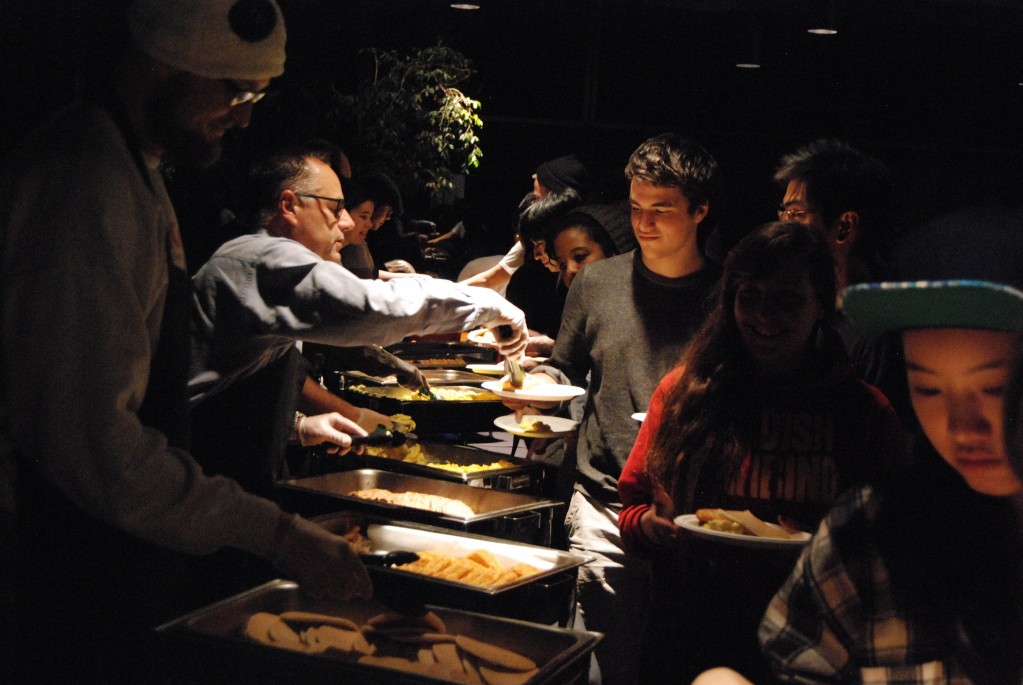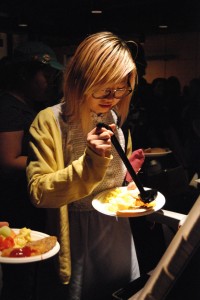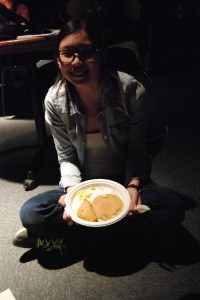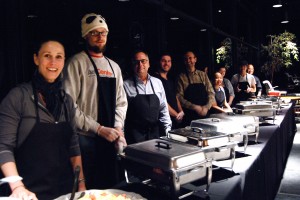For Art Center students, it’s the most anticipated meal of the term
Like holiday crowds at a big box store, students begin lining up well before the doors open. What’s the big attraction? Art Center’s Late-Night Breakfast, a longtime tradition sponsored by the Center for Student Experience (CSE), that treats students to a free breakfast buffet in the feverish final weeks of the school term. The student dining room is currently open 24 hours a day (even when food is not being served) and usually packed at this hour. The hard part, says Cafeteria Manager Ben Herrera, is clearing everyone out to set up for the event.

Provost Fred Fehlau joins fellow volunteers in serving students Late-Night Breakfast on Wed., April 10, 2013. All photos by Sylvia Sukop.
On this Wednesday night, Herrera joins nearly a dozen staff and executive team members—along with one student—volunteering their time in a show of support for students in the throes of finals. Donning black aprons and transparent latex gloves shortly before 10 p.m., the volunteers take their places behind eight stainless steel serving trays and two giant bowls of fruit salad spread out on a long table.
“What are you serving?” asks Betsy Edmunds, Associate Director of CSE’s Student Development Programs, as she walks the line greeting her team. They respond with a brightness usually reserved for daylight hours. Pancakes! Hash browns! Sausage patties! Scrambled eggs with cheese!
“Foods to help keep the students up,” says Jim Jauregui with a knowing smile, as he arranges a selection of tea bags at another table nearby. On Art Center’s cafeteria staff for 11 years, he’s played an instrumental role in this ritual more times than he count. The plates are a different story: “That’s 375 right there,” he says, pointing to three tall stacks of biodegradable plates. “We’ll see how far they go.”
Massed in the hallway, the students are ready to eat. When the cafeteria doors finally swing open, Esther Kiu is among the first wave of students that pours through. The second-term Photo student has spent most of her evening downstairs in the darkroom, working on a series of 10 nudes for her Advanced Processing class. At his serving station, student volunteer Victor Hung places two fluffy pancakes onto Esther’s plate; using a plastic ladle she smothers them in maple syrup.
What’s it like in the darkroom as the end of the term approaches? “I like analog, and I like to work slow,” Kiu says, “but now we have to work fast—rush, rush, rush!”
Provost Fred Fehlau, manning the hash brown and sausage stations, is a veteran of Late-Night Breakfast. “I’ve been doing it since the beginning,” he says, adding that he’ll see some students tonight that he seldom otherwise sees. “Students are always hungry,” he grins.
There’s no question the event offers momentary respite to Art Center’s famously hardworking students. But really, is it that big a deal?
“God yes!” says Advertising student Abe Chuang, sitting on the floor in a circle of friends all savoring their selections from the buffet. “We wait for it from week one.”
“I wish it happened every week,” interjects Jessica Muljadi, sitting cross-legged and balancing a plate of pancakes on her knee.
“But if it happened every week that would take the specialness away,” says Chuang, scooping up another fork-full of his fruit salad.
When students are pushing themselves to the limit to meet final deadlines, specialness goes a long way. Late nights are the norm and expressions of solidarity—both official and unofficial—are important.
“Since we work late it’s better to work together,” says Muljadi, a fourth-term Graphics student. “At 3 a.m. when you’re working alone you can start to break down because of the pressure, you can see people cry.”
Has she seen someone crying? “Yes—me!” she replies, bursting into laughter.
Second-term Entertainment Design student Gerland Buckens has come straight from the workshop where he’s been working on a helmet for 3D Fundamentals 2. A classmate sitting beside him wears a respirator draped around her neck as she eats. Are they worried about finishing their projects on time? “I don’t think about it,” Buckens says matter-of-factly in between bites, “it just happens. A week from now it’ll all be over.”
Breakfast too is now over, and Herrera tallies up the consumption: 400 plates of food, and more than 10 gallons of coffee.
“But no decaf,” he winks. “Everybody wanted regular.”
—Sylvia Sukop











